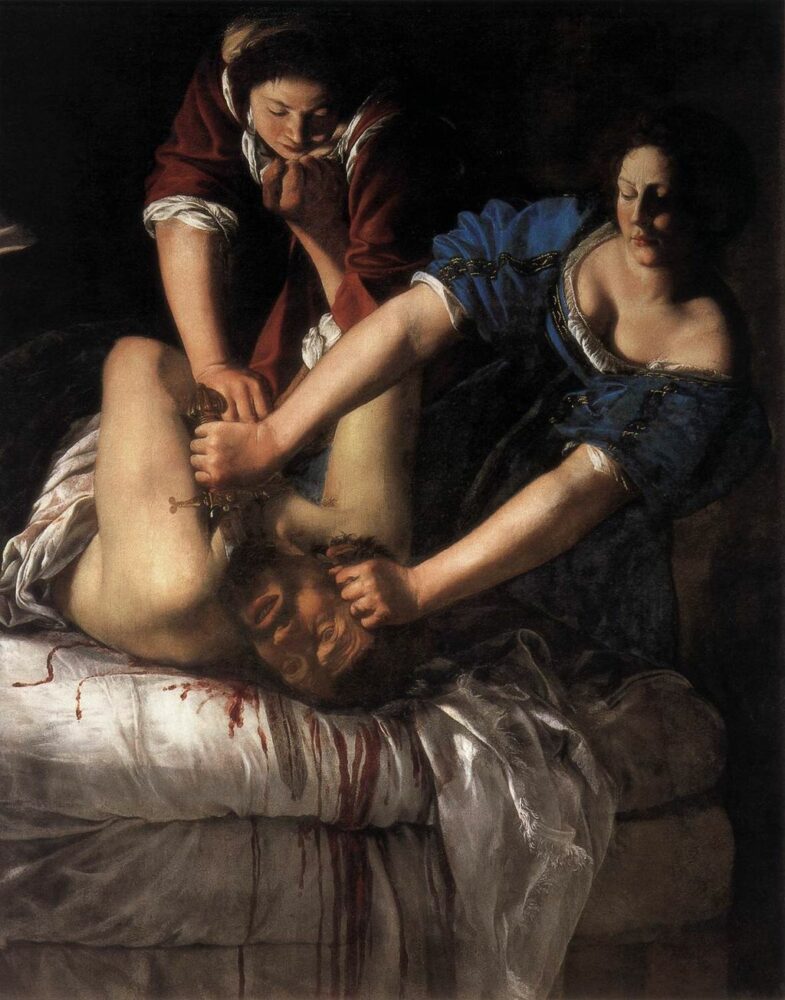
Editor’s Note: In honor of Women’s History Month, we’re sharing profiles of remarkable women in art we think you should know (if you don’t already).
Women do not often feature in the patriarchal pages of medieval history, unless they’re queens or saints. But Artemisia Gentileschi – neither a royal nor religious devotee – manages to stand out as a Renaissance artist, in part because of a horrific experience she endured.
Artemisia is best-known for her 1620 painting, Judith Slaying Holofernes, which depicts two women sending a sword right through a man’s neck as they hold him down, killing him as he struggles. The scene is from The Book of Judith, in which Judith, a Jewish widow, kills an invading Assyrian general named Holofernes, in retaliation for his attacks on her people.
But Artemisia’s depiction of this story holds references to her own life — specifically, her rape at the hands of one of her father’s friends when she was a teenager. Rather incredibly for those times, historical records indicate that the case was actually brought to court, where she testified and he was found guilty. The experience was defining for Artemisia, and it becomes almost impossible to look at Judith Slaying Holofernes without seeing her own anger at her rapist, and a desire for righteous revenge.
She was about 27 years old when she completed Judith Slaying Holofernes. Born in Rome, Artemisia was the daughter of a painter, and like many young aspiring female artists of that time (see Catharina van Hemessen), she was likely trained by her father, Orazio Gentileschi. At a young age, she stepped in to help raise her three younger brothers after her mother died in childbirth. Amidst the heartache, she began to paint, and displayed such talent that her father said of her skills by the age of 18 that she was “peerless.” Her paintings of classical allegories and Biblical stories have an undeniable feminist bent…an air of resistance, if you will. Susanna and the Elders, painted when she was just 17, depicts a story from the Book of Susanna in which the young Susanna shields herself from two older men who spy on her as she bathes. Typically, when this subject was painted by other artists, Susanna doesn’t seem to put up much of a fight as her personal space is violated. Unsurprisingly, these versions are painted by men. But in Artemisia’s version, Susanna contorts her body and turns her face away, hands outstretched almost as if to push the two elders away. She is making her discomfort known.
Beyond her beautiful execution of the human form, of light and shadow and delicate folds of fabric, what made Artemisia so extraordinary was her treatment of the female experience in her art. As Rebecca Mead noted in The New Yorker, “Artemisia claimed women’s resistance of sexual oppression as a legitimate subject of art.” And because she did so, we now have invaluable knowledge and insight in the life of not only Artemisia, but women like her. Her work gives voices to the voiceless, and shines a light on the type of violence women have been experiencing since the beginning of time. ◼
Victoria Flexer, author of “A History of the World in Ten Dinners,” received her master’s degree in historical studies from The New School. She specializes in sharing history through food, art and culture.



